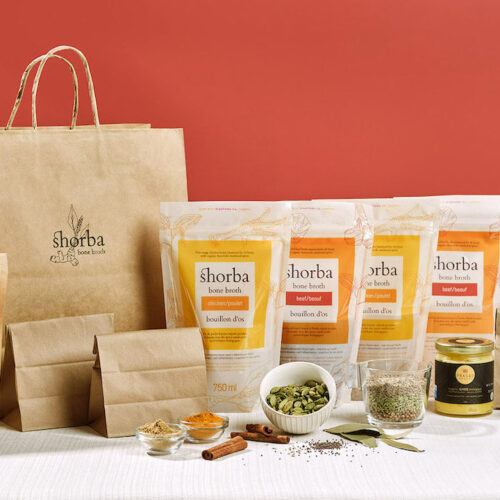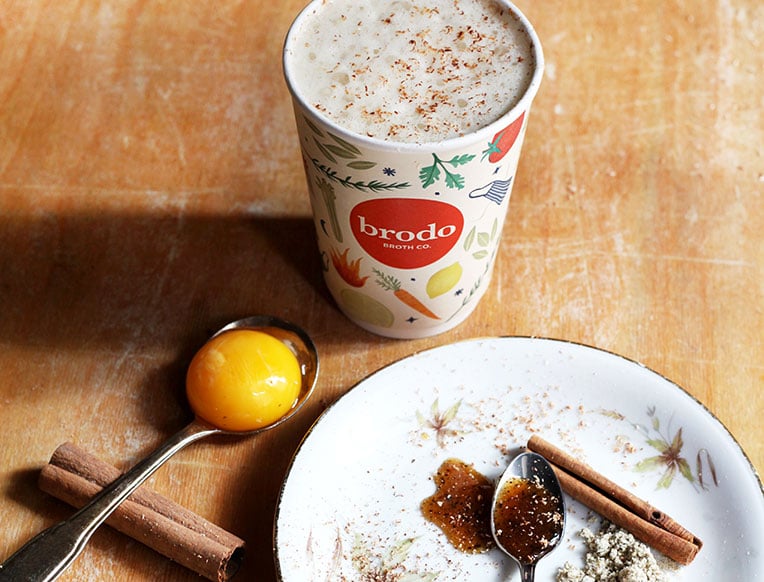How to Make Beef Bone Broth: A Step-by-Step Overview for Delicious Homemade Nourishment
Beef bone brew is a healthy addition to any type of kitchen. It offers numerous health and wellness advantages and can improve a range of recipes. The procedure starts with picking the appropriate bones and components. Understanding each step is important for accomplishing the best taste and richness. Nevertheless, lots of home cooks overlook essential methods that can boost their broth. What are these techniques, and exactly how can they change a straightforward broth into a cooking staple?
Recognizing the Conveniences of Beef Bone Broth
While many people enjoy the abundant flavor of beef bone broth, they may not completely value its various health advantages. This nourishing elixir is recognized for its high collagen web content, which sustains joint health and wellness and promotes skin flexibility. The amino acids located in bone brew, such as glycine and proline, play substantial roles in muscular tissue repair work and digestive health and wellness. In addition, it is abundant in minerals like calcium, phosphorus, and magnesium, vital for keeping strong bones and overall health. Bone broth likewise has anti-inflammatory homes, which can relieve signs related to chronic problems. Eating it may support digestive tract health and wellness by boosting the mucosal cellular lining of the gastrointestinal tract, promoting far better nutrient absorption. Additionally, the warmth and convenience of a steaming bowl of brew can give a relaxing effect, making it a healthy and scrumptious selection for individuals seeking both cooking pleasure and health advantages.
Choosing the Right Bones
The structure of a tasty and nourishing beef bone broth hinges on the selection of bones. For optimal outcomes, it is important to select a selection of bones that give a rich blend of flavor and nutrients. Marrow bones, which consist of the fatty, gelatinlike marrow, are especially treasured for their ability to improve the brew's richness. Joint bones, such as oxtails and knuckles, are additionally useful since they are high in collagen, adding to a silky structure. In addition, including some meaty bones can add deepness to the flavor account. Sourcing bones from pasture-raised or grass-fed livestock is recommended, as these alternatives tend to supply exceptional top quality and taste. It is likewise essential to identify the bones are fresh and cost-free from any kind of repulsive odors. By carefully picking the ideal bones, one can prepare for a tasty and beneficial beef bone brew.
Necessary Components for Flavorful Broth
To create a delicious beef bone broth, choosing high quality beef bones is important as they offer as the foundation of the meal - Bone Broth Vancouver. Fragrant vegetables and a careful option of seasonings and natural herbs additionally boost the broth's depth and complexity. With each other, these important ingredients add to a rich and rewarding taste profile
Top Quality Beef Bones
Quality beef bones act as the structure for a abundant and flavorful broth. The most effective options include marrow bones, knuckle bones, and oxtails, each contributing unique structures and flavors. Marrow bones are prized for their gelatin content, which aids produce a smooth mouthfeel. Knuckle bones, abundant in collagen, improve the broth's body and dietary profile. Oxtails supply a hearty preference and additional richness. It is crucial to resource bones from grass-fed or pasture-raised livestock, as this improves the overall top quality and flavor of the brew. Quality is likewise crucial; bones must be used within a couple of days of purchase or iced up for later use. Choosing high-grade beef bones assures a scrumptious and beneficial final product.
Fragrant Veggies Selection
While picking aromatic veggies, one should think about the role they play in enhancing the total taste account of the beef bone broth. Usual options consist of onions, carrots, and celery, usually described as the "mirepoix." Onions add sweet taste and depth, while carrots contribute a refined earthiness. Celery supplies a revitalizing clarity that balances the richness of the brew. Garlic, though optional, can present a durable flavor, enhancing the savory notes of the beef. Leeks and shallots are likewise outstanding enhancements, providing special taste dimensions. For a hint of heat and intricacy, some may include ginger or fennel. Selecting a mix of these aromatic veggies guarantees a versatile and delicious brew, setting the foundation for a beneficial culinary experience.
Flavorful Herbs and Spices
Integrating savory natural herbs and seasonings is important for boosting the taste of beef bone brew, as they present fragrant complexity and depth. Common selections consist of bay leaves, which impart a subtle organic note, and thyme, understood for its natural taste. Rosemary, with its click to read pine-like essence, adds a revitalizing touch, while parsley adds illumination and quality. For a tip of heat, black peppercorns and garlic are exceptional additions, enhancing the brew's total richness. Furthermore, pepper flakes or chili powder can present a gentle heat for those who choose a little flavor. Selecting a balanced combination of these components not just enhances taste but also infuses the broth with useful nutrients, making it a nourishing and scrumptious option for any kind of meal.
Preparing the Bones and Vegetables
To produce a tasty and abundant beef bone brew, the prep work of vegetables and bones is important. Initially, selecting high-quality beef bones, such as oxtail, marrow, or knuckle, is important, as they provide the essential collagen and nutrients. Toasting the bones in the stove boosts their taste, offering the brew a much deeper, richer preference. It is advisable to roast them at 400 ° F for regarding thirty minutes, till browned.Next, vegetables play a pivotal function in structure flavor. Typical options consist of onions, carrots, and celery, referred to as the mirepoix base. These need to be approximately sliced to optimize taste extraction during simmering. Garlic and tomatoes can additionally be consisted of for additional depth.Lastly, washing the vegetables and bones under cold water assists eliminate any kind of pollutants, guaranteeing a clear brew. Properly preparing veggies and bones sets the structure for a nourishing and scrumptious beef bone broth.
Cooking Approaches: Stovetop vs. Slow Stove
When it concerns cooking beef bone brew, the choice in between stovetop and slow-moving stove techniques offers distinctive benefits. Stovetop food preparation permits quicker results and more control over the simmering procedure, while sluggish stoves provide benefit and an extensive mixture of flavors. Each technique has its special advantages, accommodating different preferences and routines.

Stovetop Cooking Benefits
While both stovetop and slow-moving cooker approaches have their benefits, stovetop food preparation provides unique advantages that can enhance the procedure of making beef bone brew. One considerable advantage is the capacity to control the temperature and simmering time extra exactly, which can bring about ideal extraction of nutrients and flavors from the bones. Furthermore, stovetop cooking enables real-time modifications, enabling the cook to check the broth's consistency and preference throughout the process. The quicker cooking time compared to reduce stoves can additionally be useful for those needing broth in a shorter duration. The stovetop method urges a hands-on technique, cultivating a much deeper connection to the cooking procedure and possibly resulting in a much more savory end item.
Slow Cooker Advantages
Using a slow cooker for making beef bone brew provides several distinct advantages that appeal to lots of home chefs. One primary benefit is the ease of set-it-and-forget-it cooking. As soon as the active ingredients are combined, the sluggish stove can run ignored for hours, enabling a hectic timetable without continuous monitoring. Furthermore, slow cookers keep a regular low temperature level, which extracts flavors and nutrients effectively with time without the danger of boiling, resulting in a richer brew. The energy efficiency of sluggish stoves likewise sticks out, as they utilize much less electrical energy compared to stovetops (Where To Buy Bone Broth Near Me). Furthermore, sluggish cookers commonly have programmable setups, making it possible for exact control over cooking times, which improves the total convenience of broth prep work
Stressing and Storing Your Broth
Straining and saving beef bone brew is a crucial action that ensures a clear, delicious end product. When the brew has actually simmered for the recommended time, it needs to be carefully put via a fine mesh strainer or cheesecloth right into a big bowl or pot. This process removes any type of solids, such as meat, vegetables, and bones, guaranteeing a smooth uniformity. To capture all taste, pressing the solids delicately with a spoon can be beneficial.After stressing, the broth should cool down to area temperature prior to being saved. It is best to use impermeable containers, such as glass jars or freezer-safe bags, to avoid freezer melt and maintain freshness. Classifying the containers with the date is also recommended. The brew can be refrigerated for up to a week or iced up for a number of months, making it a convenient enhancement to future meals. Appropriate storage space assurances that the dietary advantages and tastes remain undamaged.
Creative Ways to Use Beef Bone Brew
Beef bone brew offers a functional foundation for a variety of meals, enhancing both flavor and nourishment. Home cooks can incorporate it right into soups and stews, providing an abundant base that deepens the general taste. It can also be utilized as a cooking liquid for grains, such as rice or quinoa, instilling them with added nutrients and flavor.Additionally, beef bone brew acts as an exceptional structure for gravies and sauces, lending complexity and richness to meals. For those looking for a healthy and balanced beverage, drinking warm brew can be soothing and beneficial. It can also be used in healthy smoothies for a protein increase, though this might websites require some innovative flavor balancing.Ultimately, beef bone broth not only elevates day-to-day dishes however also adds to a wholesome diet, making it a staple active ingredient for cooking enthusiasts and health-conscious individuals alike.
Regularly Asked Concerns
For How Long Can I Store Beef Bone Broth in the Refrigerator?
The inquiry of storage space duration for beef bone broth in the refrigerator is crucial. Typically, it can be safely saved for regarding 3 to five days, ensuring freshness and high quality prior to consumption or cold for longer conservation.
Can I Freeze Beef Bone Brew, and for How much time?
Beef bone brew can be frozen effectively, enabling for prolonged storage space. When appropriately secured in closed containers, it can last up to six months in the fridge freezer, protecting its taste and dietary advantages for later use.
Is It Safe to Make Use Of Bones From a Food Store?
The security of using grocery shop bones relies on their resource and handling. If correctly sourced and saved, these bones can be secure for intake, offering necessary nutrients when ready appropriately for brew.
Can I Make Beef Bone Brew in an Immediate Pot?
The Instantaneous Pot is undoubtedly suitable for making beef bone broth - over here Bone Broth Vancouver. Its pressure food preparation function substantially lowers cooking time while still removing abundant flavors and nutrients, making it a convenient choice for active home cooks

What Nutritional Differences Exist In Between Beef and Hen Bone Broth?
The nutritional differences in between beef and chicken bone brew largely hinge on their collagen material, amino acids, and mineral profiles. Beef brew typically consists of more collagen and minerals, while poultry broth is usually lighter and less complicated to absorb. The structure of a tasty and healthy beef bone broth lies in the choice of bones. To develop a savory beef bone broth, picking top quality beef bones is important as they offer as the foundation of the meal. The finest choices consist of marrow bones, knuckle bones, and oxtails, each contributing unique structures and flavors. While selecting fragrant vegetables, one need to think about the duty they play in enhancing the general flavor account of the beef bone broth. To develop a abundant and tasty beef bone broth, the preparation of veggies and bones is important.